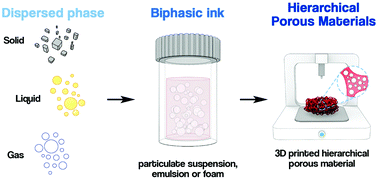3D printing of biphasic inks: beyond single-scale architectural control
Abstract
To date, Additive Manufacturing (AM) has come to the fore as a major disruptive technology embodying two main research lines – developing increasingly sophisticated printing technologies and new processable materials. The latter has fostered a tremendous leap in AM technological advancement, allowing 3D printing to play a central role in dictating the tailorable settings for material design. In particular, the manufacturing of three-dimensional (3D) objects with functional hierarchical porous structure is of the utmost importance for numerous research areas, including tissue engineering, catalysis, aerospace, environmental science, electrochemistry, energy and sound absorption and light engineering materials. Biphasic inks such as emulsions, foams, and solid dispersions represent viable templating systems to realise multiscale porosity. The combination of AM techniques and biphasic inks provide pivotal control over multiple levels of material structure and function, enabling the use of advanced materials with unprecedented 3D architectures as well as physical, chemical, and mechanical properties. The related potential benefits are significant, with functional perspectives for a wide variety of research fields. In this concise review, we provide an updated overview of the employment of biphase inks and show how they are adapted to different AM technologies or vice versa.



 Please wait while we load your content...
Please wait while we load your content...